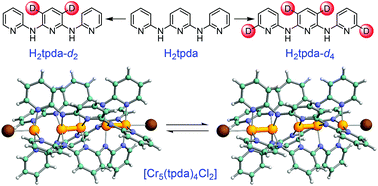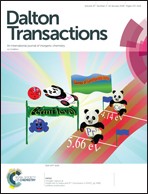Solution structure of a pentachromium(ii) single molecule magnet from DFT calculations, isotopic labelling and multinuclear NMR spectroscopy†
Abstract
The structure of pentachromium(II) extended metal atom chain [Cr5(tpda)4Cl2] (2), which behaves as a single molecule magnet at low temperature, was investigated by Density Functional Theory (DFT) calculations and spectroscopic studies without the constraints of a crystal lattice (H2tpda = N2,N6-bis(pyridin-2-yl)pyridine-2,6-diamine). DFT studies both in the gas phase and including CH2Cl2 solvent effects indicate that an unsymmetric structure (C4 point group), with pairs of formally quadruply-bonded metal ions and one terminal metal center, is slightly more stable (2.9 and 3.9 kcal mol−1) than a symmetric structure (D4 point group). Isotopically-labelled samples (2-d8 and 2-d16) have then been prepared to aid in molecular symmetry determination by combined 1H and 2H NMR studies in dichloromethane solution. The spectra are strongly suggestive of a symmetric (D4) framework, indicating fast shuttling between the two unsymmetric forms over the timescale of NMR experiments. Procedures for a high-yield Pd-free synthesis of H2tpda and for site-selective post-synthetic H/D exchange of aromatic H2tpda hydrogens are also reported.



 Please wait while we load your content...
Please wait while we load your content...